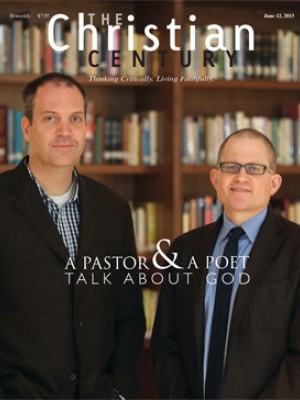Poor and unwanted: Sociologist Susan Crawford Sullivan

For her award-winning book Living Faith: Everyday Religion and Mothers in Poverty, Susan Crawford Sullivan interviewed a diverse group of women who were living in poverty. She asked them about the challenges of parenting, working and surviving on little income. She discovered that many drew on strong religious beliefs as they struggled with everyday problems. Sullivan teaches sociology at the College of the Holy Cross.
How would you describe the religious lives of the women who participated in your study?
Most of the women identified themselves as having no religion, yet 80 percent of those still said that religion was important in their lives. Most women offered theological explanations for the things that happened in their lives. A woman might say that she became homeless as a part of God’s plan, because now she was going to get better housing through the shelter than she could have on her own. One woman told me that her homelessness was part of God’s plan because now she had more opportunities to share her faith, including sharing it with me. They framed suffering in terms of character development.
Read our latest issue or browse back issues.
I kept waiting for them to say something like, “We live in a really expensive city where rents are incredibly high, and it is really hard for a low-income person to find housing.” Instead they gave very individualistic explanations. Because the narrative of individualism is so powerful in our culture, none of the women ever gave any kind of social-justice explanation.
What relationship did these women have to churches?
For the most part, their relationships to churches were only through their children. They felt that a church would provide a framework for understanding and surviving life’s hardships and that church members would reinforce the lessons they tried to teach their children. Many of the women felt that they were in an uphill battle in their neighborhoods against drugs and crime and that the church could provide a safe alternative.
Why didn’t they go to church themselves?
The women felt unwanted. It was hard to know how much of this was their perception and how much was being communicated by church members. One pastor told me he had the sense that these women thought the opportunity for a church-oriented life had already passed them by; they had made too many mistakes. The women largely felt that they didn’t have a “church lifestyle.” They would say, “I swear” or “I smoke” or “I sin.”
About a third of the women in my study felt stigmatized by churches. Some mentioned not having nice clothes. Some were ashamed of being on welfare, even though no one would know. One woman was terribly ashamed of having gone to jail for selling drugs and having lost her children. She hadn’t gone back to church since getting out of jail. I asked, “Would the people not welcome you back?” “Oh, no, no,” she said. “They would be glad to see me, but I just don’t feel right about it.” African-American women were more likely to say that they would be welcome in church; white women were more likely to express feeling stigmatized. But overall, it was much more of a subtle feeling of being excluded that they expressed, rather than that a church had said, “You are not welcome.”
Did any of the women have a vital relationship with a church?
One white Catholic woman did, but she was an exception. She lived near her church, so transportation wasn’t an issue. A single mother with two girls, she struggled with depression. She had received a lot of support from her parish priest to get her GED and then to get a certificate to work with special-needs children. She went to church every week and was in a Bible study group. She prayed for other members of the church community, and they prayed for her. She said that sometimes when in the depth of depression she would feel there was no way she was going to make it, but then the church would come to her aid. She just had a different relationship to her church than almost any of the other women.
Are churches to blame for this dynamic?
The rejection runs both ways. Some strong cultural factors are at work—ideas about what a church lifestyle is, what you might have to change if you go to church. On the other hand, a survey done a number of years ago in an urban housing project found that a very high percentage of the people living there had never been contacted by a church—not even with a flyer or any kind of information about a church. In the middle of all the stress of losing your housing and struggling to survive, shopping for a church doesn’t become a priority. Omar McRoberts studied the Dorchester area of Boston and found that most of the churches there didn’t want to have a lot of contact with the very poor.
One African-American pastor I talked to told me that one of his church members came up to him and said, “Pastor, why do we always attract the alcoholics and the drug addicts and the people who have been in jail? What do they do for us? They don’t put anything in the collection plate; they are uneducated.” The pastor said to me, “There is an attitude among church members: ‘We’ve struggled long and hard, and we’ve managed to make it. If you haven’t, then that’s your shame.’ They also have the idea that there is a bad element that we have to keep away from our children.” Studies show that church members often feel that they don’t want their children to have contact with children from housing projects.
Another pastor talked about her efforts in “educating in hospitality.” She told about inviting some mothers from a nearby shelter to come to her church for a mothers’ gathering of some kind. When they came, no one was unfriendly, but people just didn’t know how to engage the visitors. She said, “I don’t think those women will ever come back. I can’t tell people: Come, you will feel welcome.”
What would you want pastors to know about the women who participated in your study?
I would tell them about a very religious woman I called Rebecca. She lived in a shelter. She had no long-term housing or means of transportation. She prayed and read the Bible with her children every night. She does go to church, but whenever she goes, she feels ashamed. She interacts with no one. Her longing for church is very apparent. She said to me, “I never had a family. When you live in a shelter and you move here and there, you don’t have long-term relationships. I know people who belong to churches who when they need someone to look after their kids, they can trust a church member. I’ve never had that.”
There has to be a better way to connect with such a person. Her children could be involved in activities at church. People in the church might be able to connect her with jobs or job training. But the church would need to make her feel welcome, make her feel like a full-fledged member. She needs to feel that she is contributing and participating. That might reduce her self-blame and her isolation.
How did you get into this topic?
When I started the study I was interested in people’s transition from welfare to work. I had my first baby not too long after the welfare reform of the 1990s, and I was surprised when I met conservative evangelical or Catholic women who would frame their decision to stay home and take care of their children in religious terms or in terms of God’s will. They would say that it is God’s will for mothers to be at home taking care of babies. The new rules of welfare reform insisted that mothers go back to work. So I wanted to look into how this work-family dilemma affected women who had children who were not of school age.







